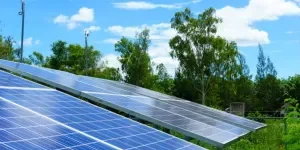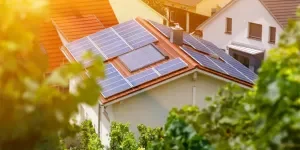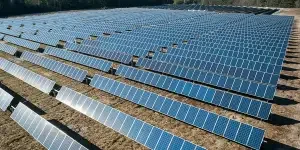Hydropower is the most widely used renewable energy source of electricity across the world. Hydroelectric generators are widely available, with the largest ones used for hydroelectric power stations, sited at reservoirs and dams, to the smallest ones used for domestic and rural applications. This article offers some guidance in selecting the most suitable hydroelectric generators for your requirements.
Table of Contents
Global market projections for hydroelectric generators
An introduction to hydroelectric generators
Types of hydroelectric turbines
A look at the range of hydroelectric generators available
Final thoughts
Global market projections for hydroelectric generators

The global market for hydroelectric generators is growing well at a compound annual growth rate (CAGR) of 6.8% over the 10-year period from 2022 to 2032. In 2022, the market value was US$ 137.6 billion, growing to US$ 264.41 billion by 2032.
Market share is led by the large hydro-plant fixed systems at 63%, over smaller portable systems at 37%, although smaller systems are projected to grow faster at a CAGR of 7.8%.
Asia Pacific leads the current usage and projected market growth, with China the biggest producer of large dam-based hydroelectric power. Smaller systems are finding growth worldwide due to the increased interest in renewable energy sources. Smaller systems are lightweight and easy to install in locations such as farms and smallholdings to supplement other sources of energy generation.
An introduction to hydroelectric generators

Civilizations have been using the power of water for over 2000 years. In the modern era, over 70% of the world’s electricity is generated by hydropower, making it easily the most widely used source of renewable power across the world.
Hydroelectric generators use the force of flowing water to generate electricity. They do this by passing water through the fan blades of a turbine. The blades act like a propeller to turn a metal shaft, which then turns a motor. The motor generates electrical energy. The size of the turbine and the flow of the water determine the amount of electricity that is generated.
Water flow is achieved through a few direct flow methods:
- Water is released from a captive source such as in a reservoir, or from the natural flow of a waterfall or flowing river. In this way, gravity is the main force driving the water through the turbine.
- Water is redirected from another source, to flow through the turbine. This is often created by channeling a larger body of water, such as a river, into smaller and smaller channels and pipes. This process can generate high pressures for pushing through the turbine blades.
- Water is pumped upwards to a stored facility, such as a reservoir, which then releases that water to flow downward through gravity into the turbine. This method requires power to push the water upwards, so is most efficient when renewable energy sources are used to create that power.
The diagram above from Chengdu Forster Technology Company shows an example of an hydroelectric power plant sited at a reservoir, using gravity water flow through the power plant turbine.
Using water from natural sources makes the hydroelectric generator a renewable energy, but the principle is actually the same for fossil fuel power generation. Coal-fired power stations use coal to heat water, to create steam, which is then forced through the turbine.
The Three Gorges Dam, which spans the Yangtze River in China is the largest hydroelectric power station in the world, with 32 x 700 Megawatt (Mw) turbines, and two more 50 Mw generators that supply power to the power station itself.
Hydroelectric generators with capacity below 5 Kilowatts are commonly used in farms, small-holdings, and small industries, and in off-grid or hybrid power uses. For generators 5 Kilowatts and above, application can include powering small communities, rural industries and larger agricultural needs.
Types of hydroelectric turbines

Hydroelectric turbines generate their power from the combination of pressure and flow of the water. Pressure, or force of the water, is determined from the height of the water source, called the ‘head’. Flow of the water is both the volume and speed of the water
There are different types of turbines, suited to varying types of head and water flow. The main two types are reaction, and impulse.
Reaction turbines have their turbine blades sited fully within the flow of water and are turned as the water flows over the blades, with all blades in contact with the water flow. Types of turbine blades used include propeller (as for a boat propeller), Kaplan (adjustable blades), kinetic (direct from the flow), and Francis turbine (like the blades on a jet engine). Turbine blade type is chosen based on the head and flow of the water, with each having their benefits. Most reaction turbines are used for lower head and higher flow, although Kaplan turbines are also suitable for high head.
Impulse turbines generate their power from the flow of water, to move the wheel (runner). With Pelton impulse turbines, only part of the runner is in contact with the flow of water (imagine a water wheel at a mill). As the flow turns the runner, each new blade enters the flow and the motion continues. Pelton turbines work well for high head and low flow. Cross flow turbines allow the flow across a wider part of the turbine wheel, capturing the flow on in-flow and out-flow. These work well for very high flow and low head water.
A look at the range of hydroelectric generators available

The large hydroelectric power stations around the world are usually sited on major rivers and on reservoirs, with correspondingly large, specially built, hydroelectric generators capable of 500 megawatts and above. For smaller applications, such as rural power generation, off grid agricultural and industrial systems, sizable generators are available for order online.
This section looks at a selection from the wide range of hydroelectric generators that can be sourced ‘off the shelf’ and suggests some of the applications to consider.
Large size generators
Where generating capacity exceeds 1 Megawatt (1000 Kilowatts), the amount of power produced exceeds the typical needs of a small farm or home, so their use is more suitable for industrial applications and for rural community on or off grid power supply. Such large hydropower generators would be sited close to or on a nearby water source, such as a river, lake or small reservoir. Water may be supplied directly by gravity, but is more likely pumped or redirected from a nearby source.
Smaller sized generators
Below 1 Megawatt capacity, smaller hydroelectric generators that can produce between 5 and 500 Kilowatts and more, are very suitable for small farms and large off grid housing. They are likely to be sited by small rivers and large streams where water flow is consistent to keep power generation reliable.
Micro Hydroelectric generators
Below 5 Kilowatts capacity, micro hydroelectric generators are very small, portable and easy to install for off grid homes and villages, small rural farms and cottage industries. They can be installed at streams, with easily redirected flow through supplied piping.
Educational models
There are a number of demonstration models of hydroelectric generators that are available online. These are designed for science classroom use to educate science students on how hydroelectricity works.
Final thoughts
Hydroelectric generators make use of a steady water flow to generate electricity. They can range in scale from multi-generator power plants that can produce over 20,000 Megawatts to small home kits that can produce no more than one Kilowatt. Large generators serve the needs of countries that can make use of large-scale power generation. Smaller generators are increasingly popular for off-grid power needs, small rural power generation and for those keen on renewable energy.
In choosing the right hydroelectric generator, the buyer will already be clear on the likely application, whether reservoir or large water body based, or sited at a small rural stream. Siting and intended power are the main considerations, with a secondary decision on the type of turbine that is best suited to the water pressure (head) and flow.
Potential buyers can check out the wide choice available at the Alibaba.com online showroom.



